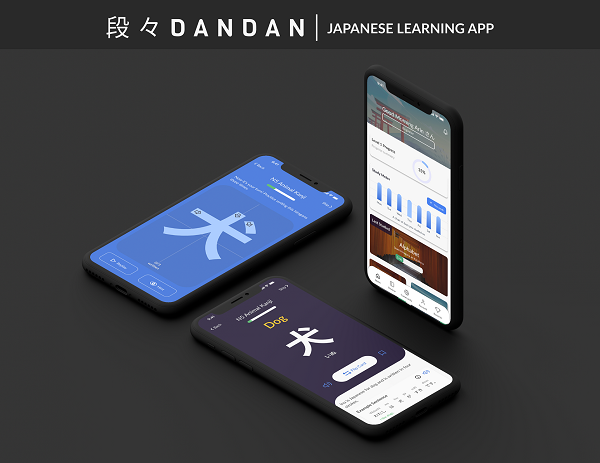
Arin Soukoule decided to create her own interdisciplinary major while earning her undergraduate degree at Queens College, the City University of New York because she was interested in pursuing a design career. None of the regular majors seemed to fit–her only other choice was to earn a BFA with a concentration in communication design, animation & illustration, or interaction design–so she designed her own major in digital communications and multimedia through the CUNY Baccalaureate program.
Her last semester of college coincided with the onset of the COVID-19 pandemic, and as lockdowns began she decided to take her future into her own hands. She chose Springboard because the program was self-paced, so she could balance the bootcamp alongside her college coursework. She had also recently met a Springboard alum in one of her design courses at Queens College, who had spoken highly of the program.
“It really helped me make the decision to proceed with enrolling in Springboard since I knew I could trust that colleague and his honest experience,” Arin said.
For her capstone project, she created a language learning app called DanDan (named after a Japanese word that means “gradually” or “little by little.” She noticed that a lot of language learning apps she used while learning Japanese lacked interactivity. For example, if a learner answered a question wrong, they would not be able to see an explanation of why and learn from their mistake.
“My goal was to ensure that users could learn Japanese gradually at their own pace while also improving their language comprehension,” said Arin, who is now a design experience analyst at Accenture Interactive.
Before Springboard, I was a digital communication and multimedia major in college. I created my own major because I've always been interested in a career in design–especially in user experience. A few summers ago, I completed an internship in digital design, which taught me that user experience design was about problem-solving. When this pandemic started, I realized we were going to be in lockdown for a very long time, and that's when I knew it was time to start investing in my UX design education.
I knew that if I really wanted to understand user experience design on a deeper level, I would need to exclusively study it through an online course, a bootcamp, or just a certification.
I'm currently an experience design analyst at Accenture Interactive and I was hired through the apprentice program. The program has prepared me to understand how to work on a team with other designers, developers, and clients. Now that the apprenticeship is nearly completed, I am currently staffed on an internal project. Each day consists of a standup, which is a meeting where I and my team will share our daily achievements from the previous day for the product that we're working on. We'll talk about our plan of action for the day. If there are any obstacles we've run into, we share those so we can let the team know.
After the standup, I will work on the project. Throughout the day there might be occasional meetings to discuss any questions or brainstorm design solutions. At the end of the day, I attend a design review, where I share updates with my team and receive feedback.

One of my most recent projects was creating a digital experience that would allow people to create exchanges with one another and how to do that in a safe and secure way.
Definitely, it's like an online community. I would say, in a sense, it kind of is like a social network. But the primary interaction within that experience is social exchanges.
I was drawn to the fact that students could learn on their own time. Since I started at Springboard during my very last semester of college, I wanted to make sure I would have the time to complete my college coursework at the same time.
At the time, I knew a Springboard alum whom I had met in a college design course. Hearing his opinion really helped make the decision to enroll in Springboard since I knew I could trust that colleague and his honest experience.
The curriculum went very much in-depth on the design process, which I appreciated. There were multiple mini-projects that helped me further understand concepts that were taught and I would review these concepts with my mentor, Angelo Presti [senior product designer at Superhive.co].
Having a mentor with whom I could meet weekly was incredibly helpful. And lastly, I really appreciated the fact that Springboard provided the opportunity for students to receive feedback on their case studies from an actual hiring manager in the field, and also gain real-world design experience with a company through the Industry Design Project.
My mentor was my accountability buddy and one of my main motivators. He was very receptive to the multiple questions I came prepared with for our weekly calls and I really appreciated that. He was also very honest when he would share his experiences working in the design field.
He also understood that I had certain things going on outside of Springboard that were affecting my performance. For example, I got an injury doing exercise and I had to take a break, and he was so understanding and patient.

Definitely. I make sure to send him messages whenever I remember something he taught me that correlates with what I'm doing now.
It was the community. Whether it was receiving guidance from my design mentor, my career coaches, or my fellow students, it really helped to surround myself with individuals who were rooting for my success. They really motivated me to do my best. Besides the community, I would definitely say the Industry Design Project was super awesome and enabled me to grow and gain more experience as a designer.
DanDan is a Japanese language learning app. My inspiration stems from my experiences studying Japanese in both high school and college. There are many language learning apps available to download, however, many students lose motivation after using them due to several factors such as a lack of interactivity, zero immersion, and students not being able to see an explanation if they answer a question incorrectly.

When a user creates their account and starts using the DanDan app, they can also engage in a community of other language learners. They can also do study sessions and review sessions. The review sessions incorporate a feature where if a user does get something wrong, they can get an explanation and see what the right answer is.
I also prototyped a rewards page where users could use the points they've gathered through their lessons and redeem them for real items related to Japan and Japanese culture. So theoretically, someone could use their points to purchase a manga comic book at a local bookstore.
I began my job search early, as soon as I published my case study for the DanDan app. At that point, I had a portfolio that I could submit with my job applications. The career coaches at Springboard had a really good understanding of the types of companies and roles I was interested in. So with their help, I created a list of companies that resonated with me. I started documenting my job search very early on.
The most challenging aspect was definitely receiving rejections. But the process has made me more resilient and it also reinforced the idea that rejection is redirection.
I care about a lot of aspects, but especially morals. If I were to research a company by reading the news, what kinds of headlines would I see? I was really intentional about identifying companies that are doing great things for the environment–such as trying to adopt sustainable practices–or they care about their users’ safety and their privacy. For me, it’s about making sure that I would feel proud about working there because the company is doing good things for their customers, employees, and the environment.
I used a portfolio builder called Adobe Portfolio. If you’re putting together your first portfolio, you don't have to create something from scratch because that only makes the process even more tedious and difficult. This way you can focus on including the important details of your projects and you can quickly add the link to your resume and LinkedIn profile.
I also did some research and identified examples of successful portfolios and resumes to use as inspiration. Finally, I would recommend having your resume and portfolio reviewed by a mentor or someone you trust.
Making a big change can be nerve-wracking, but it's important to remember that you are the main character of your life. This is your story. So it's important to show up for yourself and be your biggest supporter by saying yes to your goals and wishes–and saying yes, really to your dreams, because this is your life.









